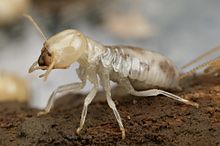Mastotermes darwiniensis
| Mastotermes darwiniensis | |
|---|---|
 |
|
| Scientific classification | |
| Kingdom: | Animalia |
| Clade: | Euarthropoda |
| Class: | Insecta |
| Order: | Blattodea |
| Family: | Mastotermitidae |
| Genus: | Mastotermes |
| Species: | M. darwiniensis |
| Binomial name | |
|
Mastotermes darwiniensis Froggatt, 1897 |
|
Mastotermes darwiniensis, common names giant northern termite and Darwin termite, is a termite species found only in northern Australia. It is a very peculiar insect, the most primitive termite alive.
This species shows uncanny similarities to certain cockroaches, the termites' closest relatives. These similarities include the anal lobe of the wing and the laying of eggs in bunches, rather than singly. It is the only living member of its genus Mastotermes and its family Mastotermitidae, though numerous fossil taxa are known. The termites were traditionally placed in the Exopterygota, but such an indiscriminate treatment makes that group a paraphyletic grade of basal neopterans. Thus, the cockroaches, termites, and their relatives are nowadays placed in a clade called the Dictyoptera. These singular termites appear at first glance like a cockroach's abdomen stuck to a termite's fore part. Their wings have the same form as those of the roaches, and its eggs are laid in a case as are roach eggs. It is thought to have evolved from the same ancestors as the wood roaches () in the Permian. Fossil wings have been discovered in the Permian of Kansas which have a close resemblance to wings of Mastotermes of the Mastotermitidae, which is the most primitive living termite. This fossil is called Pycnoblattina. It folded its wings in a convex pattern between segments 1a and 2a. Mastotermes is the only living insect that does the same.
Unlike cockroaches, only the reproductives have wings (see Life cycle of termites); wings that are considerably longer than their abdomen. Alates are approximately 35 mm long with a 50 mm wingspan. Soldiers are 11–13 mm long and workers are 10–11.5 mm long.
...
Wikipedia
